Unit 5 Dinner's ready(复习课件)-2023-2024学年四年级英语上册期末核心考点集训(共52张PPT)
文档属性
| 名称 | Unit 5 Dinner's ready(复习课件)-2023-2024学年四年级英语上册期末核心考点集训(共52张PPT) | 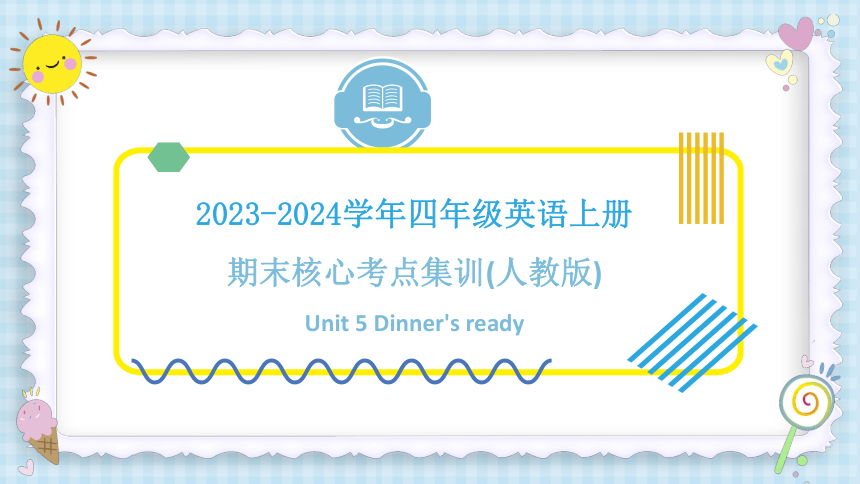 | |
| 格式 | pptx | ||
| 文件大小 | 6.1MB | ||
| 资源类型 | 试卷 | ||
| 版本资源 | 人教版(PEP) | ||
| 科目 | 英语 | ||
| 更新时间 | 2023-11-23 08:50:37 | ||
图片预览

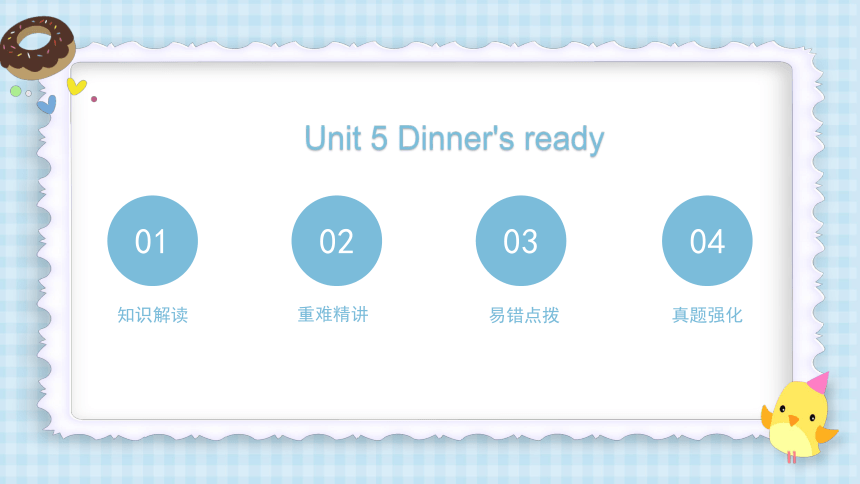


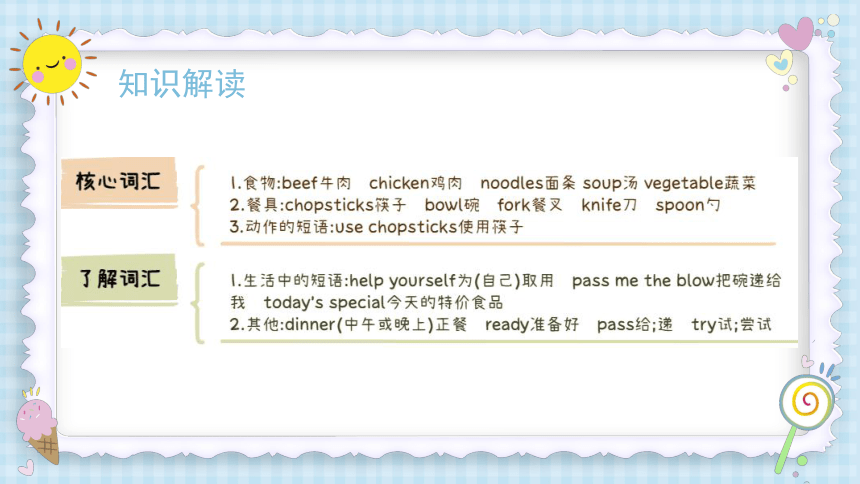
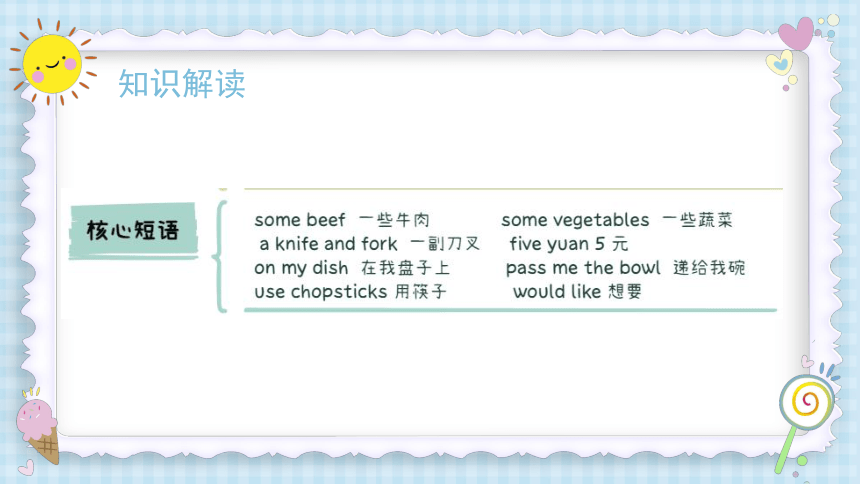
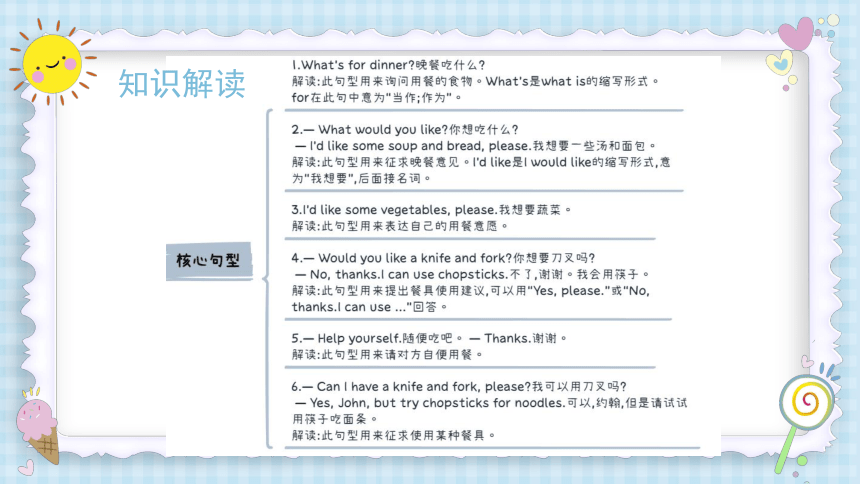
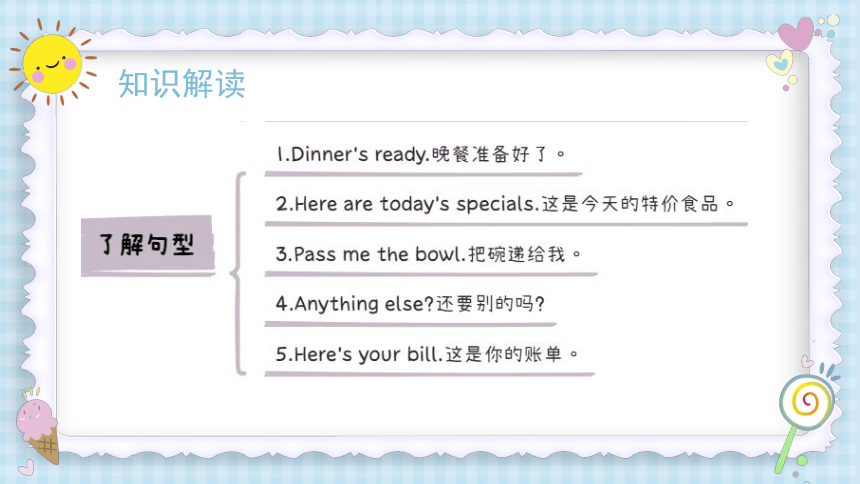
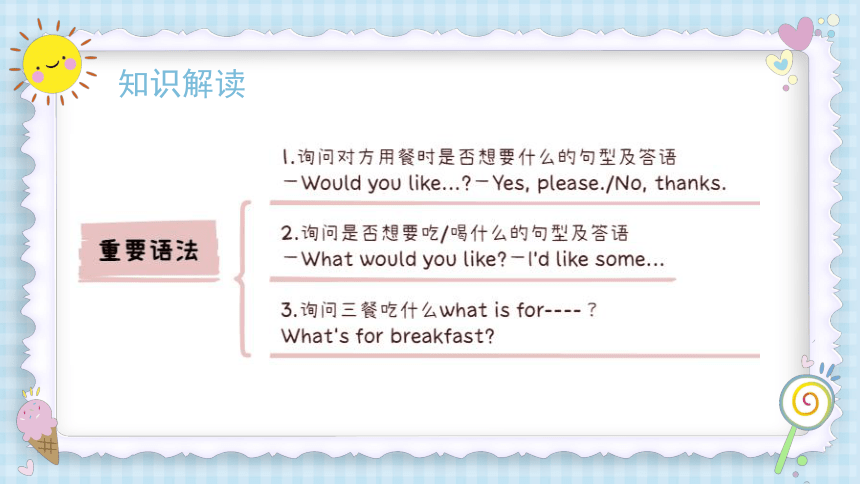
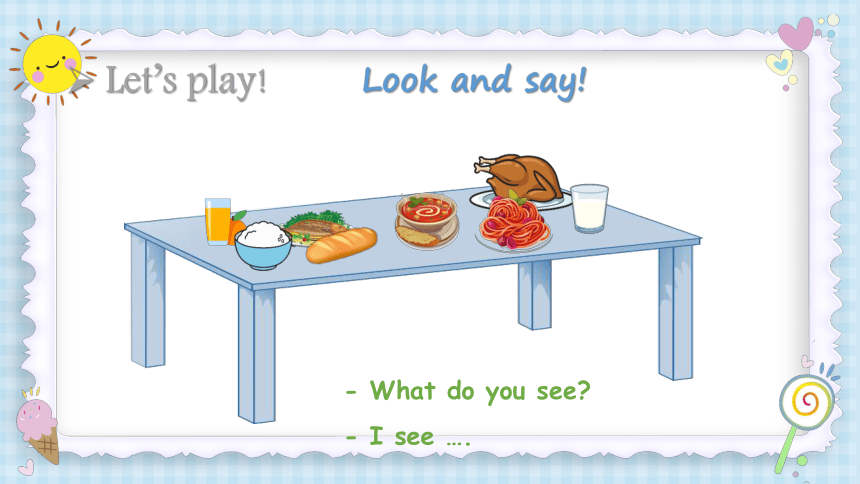
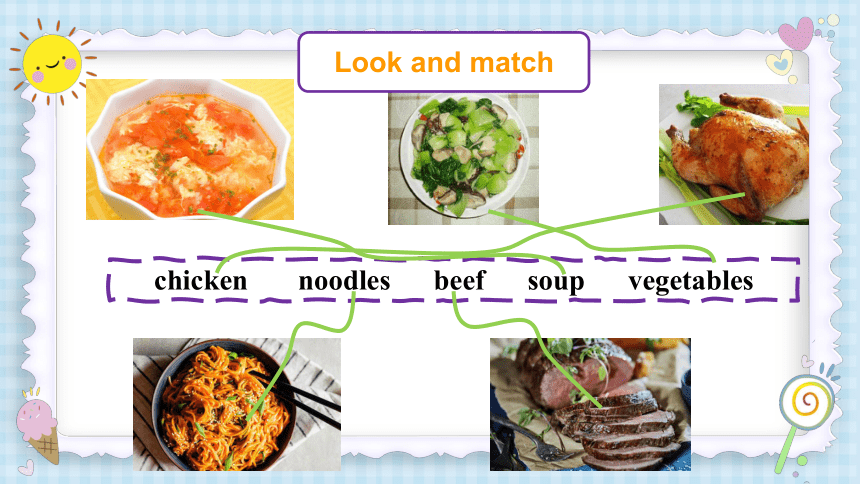
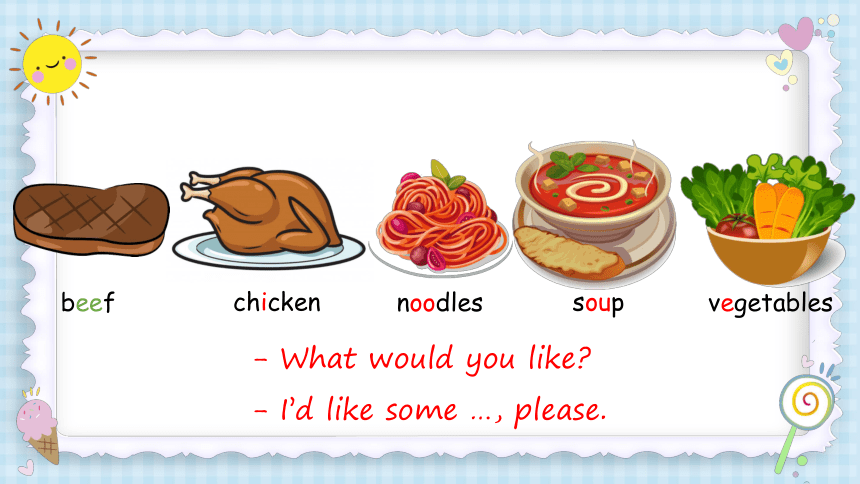
文档简介
(共52张PPT)
2023-2024学年四年级英语上册
期末核心考点集训(人教版)
Unit 5 Dinner's ready
Unit 5 Dinner's ready
知识解读
01
重难精讲
02
易错点拨
03
真题强化
04
知识解读
01
知识解读
知识解读
知识解读
知识解读
知识解读
知识解读
Let’s play!
Look and say!
- What do you see
- I see ….
chicken noodles beef soup vegetables
Look and match
noodles
chicken
beef
- What would you like
- I’d like some …, please.
soup
vegetables
juice
fish
rice
- What would you like
- I’d like some …, please.
milk
bread
词图配对,选一选。
(1) (2) (3)
( ) ( ) ( )
(4) (5)
( ) ( )
C
E
D
B
A
A.beef B.chicken C.soup D.noodles E.vegetables
重难精讲
02
重难精讲
一、字母组合e的发音规律
1.在重读开音节中,字母e发 [i:]
*例:me我 he 他 she 她 we 我们
2.在重读闭音节(辅音字母+e+辅音字母结尾)中,字母e发[e]
*例:bed 床 red 红色 get 得到 let让 pencil 铅笔
3.特殊发音:e字母在非重读音节下的发音规律:有2种发音[i]和[ ]
例如:ticket ['t k t] n.票;children ['t ldr n] n.孩子们
he, she, Lee, Eve, me
字母e都在单词末尾
red, pen, pet, desk, bed, let, get
/i:/
字母e都在单词中间
/e/
Read and find.
选出每组中字母e的发音与其他两个不同的单词。
( )1. A. egg B. leg C. me
( )2. A. red B. he C. desk
( )3. A. nose B. she C. cake
( )4. A. she B. pen C. me
C
B
B
B
What’s for dinner 晚饭吃什么?
课文例句
用法及答语:这是一个由what引导的特殊疑问句,用来询问“晚餐吃什么”
句子结构是:What’s for +三餐名词(breakfast/ lunch/dinner) 句中for 是介词,意为“(表示对象、用途等)给,对,供”,直接回答食物的名称即可。
解析
例句:—Dad, what’s for breakfast 爸爸,早餐吃什么
—Some bread and milk. 一些面包和牛奶。
拓展
表示吃三餐时,用“have/eat+三餐名词”。
例如:have/eat breakfast 吃早饭
have/eat lunch 吃午饭
have/eat dinner 吃晚饭
have/eat supper 吃晚饭
一、选择合适的选项。
1. —What’s_____lunch
——Some rice and soup.
A.of B.for C.in
B
点拨:
What’s for+三餐名称?这是what引导的特殊疑问句,三餐名称前要加介词for。三餐的名称分别是breakfast、lunch、dinner。故答案应该是B。
一、选择合适的选项。
2.——_____ is for supper
——We have some chicken and soup.
A.What B.How C.When
A
点拨:
What’s for+三餐名称?这是what引导的特殊疑问句,三餐名称前要加介词for.故答案应该是A。
What would you like 你想(吃)什么?
课文例句
用法:这是一个由what引导的特殊疑问句,用来询问“想吃什么”
句型结构:What would+主语+like
I’d like some soup and bread,please.
我想要一些汤和面包。
课文例句
句式用法:句式结构是:I’d like +食物或饮料,please.用来表达“我想要……”
句末的please(请)表示礼貌。I’d like...
= I would like... 我想要……
What would you like
I’d like .
noodles
juice
an egg
vegetables
rice
soup
fish
chicken
bread
Give him the food.
例句:—What would you like 你想要什么?
—I’d like some cakes. 我想要一些蛋糕。
例句:—What would you like for lunch
你午饭想吃什么?
—I’d like a hamburger and some milk.
我想要一个汉堡和一些牛奶。
句中的食物和饮料要注意区分单复数。
易错点
提示
—What would you like
—________.
A.I like bread B.I’d like some bread
B
I’d like some ________ and _______,please.
A.fish; vegetables
B.fishs; vegetables
C.fish; vegetable
A
would like表示“想要”,与want(想)意思相同,但是比want要客气,委婉。
拓展
Would you like a knife and fork
你想要一副刀叉吗?
课文例句
用法及答语
这是一个用来表达礼貌或者委婉地向别人提出请求、建议或者邀请的句子。
句子结构是:Would you like+餐具/食品/饮料
肯定回答“Yes, please.” 否定回答“No, thanks.”。
典例
—Would you like some milk,please
—________ I am full(饱了).
A. No, thanks! B. Yes, please.
A
例句:—Would you like an apple 你想要个苹果吗?
—Yes, please! 是的,请(给我一个吧)!
2. 妈妈问彼得午饭是否想吃面条,应该问:________
A. What would you like for lunch,Peter
B. Would you like some noodles,Peter
B
课文例句
分析
I can use chopsticks. 我会用筷子。
can的用法
can意为“能,会”,常用来表示某种能力。
例句:I can see a book.
我能看到一本书。
考向2
含有情态动词can的陈述句
当我们想表达“某人能/会……”时,可以用句型“某人+can+动词原形(动词短语)+其他”。
例句:He can clean the room.
他能打扫房间。
情态动词 can 的基本句型
肯定句:主语 + can + 动词原型 + 其他.
一般疑问句:Can + 主语 + 动词原型 + 其他
否定句:主语 + can not(can’t) + 动词原型 + 其他.
e.g. I can use chopsticks.
e.g. I can’t see you.
e.g. Can I have a knife and fork, please
一、情景交际。
1. 你邀请外国小朋友来做客,他会用筷子,他应说:________
A. Do you have chopsticks
B. I can use chopsticks.
B
易错点拨
03
易错点拨
【点拨】这道题是对询问三餐吃什么句型的考查。What’s for+三餐名称?这是what引导的特殊疑问句,三餐名称前要加介词for。三餐的名称分别是breakfast、lunch、dinner。所以答案是A。
例题1:What is______dinner?
A.for B.in C.on
易错点拨
【点拨】What would you like+for+三餐名称?此句型是what引导的特殊疑问句,would like是固定短语,意思是“想要”。如果想要问对方具体的某一餐想吃什么,要在后面接for breakfast/lunch/dinner等。所以答案是B。
例题2: ________would you like?
A.Where B.What C.Who
易错点拨
【点拨】当表示不可数名词的确切数量时,要在前面加上一些表示数量的短语,如:a glass of等。此题中some表示一些,后面跟可数名词的复数或不可数名词,因此答案选bread。因此答案选A。
例题3: I’d like some_________.
A.bread B.book C.vegetable
易错点拨
【点拨】这道题是对Here you are用法的考查。当递给别人东西时,我们常说:“Here you are.”意思为:“给你”。在不同的场合,here you are有不同的意思。此题意思:我想要一些鱼肉。答语:给你。因此答案选B。
例题4: --I’d like some fish.--____________.
A.Yes,it is. B.OK.Here you are. C.Thank you
易错点拨
【点拨】pass的意思是“给;递”,后面接名词或代词。我们可以用下面的两种方式来表达“递给某人你某物”。Pass+人+物;pass+物+to+人。因此正确答案为:A。
例题5:_____me the spoon.
A.Pass B.Cut C.Let
真题强化
04
一、判断以下单词中划线部分的发音是(T)否(F)一致。
T
T
F
F
T
T
beef soup fish juice milk fork knife vegetables chicken water bowl chopsticks noodles
食物:________________________________________
饮料:________________________________________
餐具:________________________________________
beef, soup, fish, vegetables, chicken, noodles
juice, milk, water
fork, knife, bowl, chopsticks
二、将下列单词分类,写在横线上 。
三、Word puzzles:在表格中圈出单词,看谁圈的最多。
四、用 is或are 填空。
(1) Here ________ some apples.
(2) Here ________ Tom.
(3) Here ________ your bike.
(4) Here ________ a dog!
are
is
is
is
( ) (1) Pass me the bowl.
( ) (2) Pass me the knife.
( ) (3) Cut the vegetables.
( ) (4) Use the fork.
A. B. C. D.
D
A
B
C
五、选择合适的图片。
(1) I want to eat noodles. I will use ______.
(2) Pass me the _____. I’d like some soup.
(3) After dinner I will wash the _______.
(4) I’m so thirsty. I’d like some______.
bowls
water
chopsticks
spoon
C
D
A
B
六、根据情景选择正确的单词。
七、根据图片回答问题。
1. What would you like ____________________________
2. Where is Lily
____________________________
I’d like some beef.
She is in the kitchen.
八、阅读短文, 判断正 “T” 误 “F”。
(It’s Chen Jie’s birthday. The students are having a birthday party at her home.)
Students: Happy birthday!
Chen Jie: Thank you! Let’s have dinner. What would you like, Sarah
Sarah: I’d like some fish. I like it very much.
Chen Jie: What about you, Amy
Amy: I’d like some vegetables.
Chen Jie: Would you like some chicken
Amy: Yes, please.
Chen Jie: OK. Wait a minute(等一会儿)! Let’s eat the birthday cake first!
Students: Great!
10.The students are having a birthday party.(_______)
11.They’re at school.(_______)
12.Sarah would like some meat.(_______)
13.Sarah likes fish.(_______)
14.Amy would like some fish and vegetables.(_______)
T
F
F
T
F
Thank you!
2023-2024学年四年级英语上册
期末核心考点集训(人教版)
Unit 5 Dinner's ready
Unit 5 Dinner's ready
知识解读
01
重难精讲
02
易错点拨
03
真题强化
04
知识解读
01
知识解读
知识解读
知识解读
知识解读
知识解读
知识解读
Let’s play!
Look and say!
- What do you see
- I see ….
chicken noodles beef soup vegetables
Look and match
noodles
chicken
beef
- What would you like
- I’d like some …, please.
soup
vegetables
juice
fish
rice
- What would you like
- I’d like some …, please.
milk
bread
词图配对,选一选。
(1) (2) (3)
( ) ( ) ( )
(4) (5)
( ) ( )
C
E
D
B
A
A.beef B.chicken C.soup D.noodles E.vegetables
重难精讲
02
重难精讲
一、字母组合e的发音规律
1.在重读开音节中,字母e发 [i:]
*例:me我 he 他 she 她 we 我们
2.在重读闭音节(辅音字母+e+辅音字母结尾)中,字母e发[e]
*例:bed 床 red 红色 get 得到 let让 pencil 铅笔
3.特殊发音:e字母在非重读音节下的发音规律:有2种发音[i]和[ ]
例如:ticket ['t k t] n.票;children ['t ldr n] n.孩子们
he, she, Lee, Eve, me
字母e都在单词末尾
red, pen, pet, desk, bed, let, get
/i:/
字母e都在单词中间
/e/
Read and find.
选出每组中字母e的发音与其他两个不同的单词。
( )1. A. egg B. leg C. me
( )2. A. red B. he C. desk
( )3. A. nose B. she C. cake
( )4. A. she B. pen C. me
C
B
B
B
What’s for dinner 晚饭吃什么?
课文例句
用法及答语:这是一个由what引导的特殊疑问句,用来询问“晚餐吃什么”
句子结构是:What’s for +三餐名词(breakfast/ lunch/dinner) 句中for 是介词,意为“(表示对象、用途等)给,对,供”,直接回答食物的名称即可。
解析
例句:—Dad, what’s for breakfast 爸爸,早餐吃什么
—Some bread and milk. 一些面包和牛奶。
拓展
表示吃三餐时,用“have/eat+三餐名词”。
例如:have/eat breakfast 吃早饭
have/eat lunch 吃午饭
have/eat dinner 吃晚饭
have/eat supper 吃晚饭
一、选择合适的选项。
1. —What’s_____lunch
——Some rice and soup.
A.of B.for C.in
B
点拨:
What’s for+三餐名称?这是what引导的特殊疑问句,三餐名称前要加介词for。三餐的名称分别是breakfast、lunch、dinner。故答案应该是B。
一、选择合适的选项。
2.——_____ is for supper
——We have some chicken and soup.
A.What B.How C.When
A
点拨:
What’s for+三餐名称?这是what引导的特殊疑问句,三餐名称前要加介词for.故答案应该是A。
What would you like 你想(吃)什么?
课文例句
用法:这是一个由what引导的特殊疑问句,用来询问“想吃什么”
句型结构:What would+主语+like
I’d like some soup and bread,please.
我想要一些汤和面包。
课文例句
句式用法:句式结构是:I’d like +食物或饮料,please.用来表达“我想要……”
句末的please(请)表示礼貌。I’d like...
= I would like... 我想要……
What would you like
I’d like .
noodles
juice
an egg
vegetables
rice
soup
fish
chicken
bread
Give him the food.
例句:—What would you like 你想要什么?
—I’d like some cakes. 我想要一些蛋糕。
例句:—What would you like for lunch
你午饭想吃什么?
—I’d like a hamburger and some milk.
我想要一个汉堡和一些牛奶。
句中的食物和饮料要注意区分单复数。
易错点
提示
—What would you like
—________.
A.I like bread B.I’d like some bread
B
I’d like some ________ and _______,please.
A.fish; vegetables
B.fishs; vegetables
C.fish; vegetable
A
would like表示“想要”,与want(想)意思相同,但是比want要客气,委婉。
拓展
Would you like a knife and fork
你想要一副刀叉吗?
课文例句
用法及答语
这是一个用来表达礼貌或者委婉地向别人提出请求、建议或者邀请的句子。
句子结构是:Would you like+餐具/食品/饮料
肯定回答“Yes, please.” 否定回答“No, thanks.”。
典例
—Would you like some milk,please
—________ I am full(饱了).
A. No, thanks! B. Yes, please.
A
例句:—Would you like an apple 你想要个苹果吗?
—Yes, please! 是的,请(给我一个吧)!
2. 妈妈问彼得午饭是否想吃面条,应该问:________
A. What would you like for lunch,Peter
B. Would you like some noodles,Peter
B
课文例句
分析
I can use chopsticks. 我会用筷子。
can的用法
can意为“能,会”,常用来表示某种能力。
例句:I can see a book.
我能看到一本书。
考向2
含有情态动词can的陈述句
当我们想表达“某人能/会……”时,可以用句型“某人+can+动词原形(动词短语)+其他”。
例句:He can clean the room.
他能打扫房间。
情态动词 can 的基本句型
肯定句:主语 + can + 动词原型 + 其他.
一般疑问句:Can + 主语 + 动词原型 + 其他
否定句:主语 + can not(can’t) + 动词原型 + 其他.
e.g. I can use chopsticks.
e.g. I can’t see you.
e.g. Can I have a knife and fork, please
一、情景交际。
1. 你邀请外国小朋友来做客,他会用筷子,他应说:________
A. Do you have chopsticks
B. I can use chopsticks.
B
易错点拨
03
易错点拨
【点拨】这道题是对询问三餐吃什么句型的考查。What’s for+三餐名称?这是what引导的特殊疑问句,三餐名称前要加介词for。三餐的名称分别是breakfast、lunch、dinner。所以答案是A。
例题1:What is______dinner?
A.for B.in C.on
易错点拨
【点拨】What would you like+for+三餐名称?此句型是what引导的特殊疑问句,would like是固定短语,意思是“想要”。如果想要问对方具体的某一餐想吃什么,要在后面接for breakfast/lunch/dinner等。所以答案是B。
例题2: ________would you like?
A.Where B.What C.Who
易错点拨
【点拨】当表示不可数名词的确切数量时,要在前面加上一些表示数量的短语,如:a glass of等。此题中some表示一些,后面跟可数名词的复数或不可数名词,因此答案选bread。因此答案选A。
例题3: I’d like some_________.
A.bread B.book C.vegetable
易错点拨
【点拨】这道题是对Here you are用法的考查。当递给别人东西时,我们常说:“Here you are.”意思为:“给你”。在不同的场合,here you are有不同的意思。此题意思:我想要一些鱼肉。答语:给你。因此答案选B。
例题4: --I’d like some fish.--____________.
A.Yes,it is. B.OK.Here you are. C.Thank you
易错点拨
【点拨】pass的意思是“给;递”,后面接名词或代词。我们可以用下面的两种方式来表达“递给某人你某物”。Pass+人+物;pass+物+to+人。因此正确答案为:A。
例题5:_____me the spoon.
A.Pass B.Cut C.Let
真题强化
04
一、判断以下单词中划线部分的发音是(T)否(F)一致。
T
T
F
F
T
T
beef soup fish juice milk fork knife vegetables chicken water bowl chopsticks noodles
食物:________________________________________
饮料:________________________________________
餐具:________________________________________
beef, soup, fish, vegetables, chicken, noodles
juice, milk, water
fork, knife, bowl, chopsticks
二、将下列单词分类,写在横线上 。
三、Word puzzles:在表格中圈出单词,看谁圈的最多。
四、用 is或are 填空。
(1) Here ________ some apples.
(2) Here ________ Tom.
(3) Here ________ your bike.
(4) Here ________ a dog!
are
is
is
is
( ) (1) Pass me the bowl.
( ) (2) Pass me the knife.
( ) (3) Cut the vegetables.
( ) (4) Use the fork.
A. B. C. D.
D
A
B
C
五、选择合适的图片。
(1) I want to eat noodles. I will use ______.
(2) Pass me the _____. I’d like some soup.
(3) After dinner I will wash the _______.
(4) I’m so thirsty. I’d like some______.
bowls
water
chopsticks
spoon
C
D
A
B
六、根据情景选择正确的单词。
七、根据图片回答问题。
1. What would you like ____________________________
2. Where is Lily
____________________________
I’d like some beef.
She is in the kitchen.
八、阅读短文, 判断正 “T” 误 “F”。
(It’s Chen Jie’s birthday. The students are having a birthday party at her home.)
Students: Happy birthday!
Chen Jie: Thank you! Let’s have dinner. What would you like, Sarah
Sarah: I’d like some fish. I like it very much.
Chen Jie: What about you, Amy
Amy: I’d like some vegetables.
Chen Jie: Would you like some chicken
Amy: Yes, please.
Chen Jie: OK. Wait a minute(等一会儿)! Let’s eat the birthday cake first!
Students: Great!
10.The students are having a birthday party.(_______)
11.They’re at school.(_______)
12.Sarah would like some meat.(_______)
13.Sarah likes fish.(_______)
14.Amy would like some fish and vegetables.(_______)
T
F
F
T
F
Thank you!
